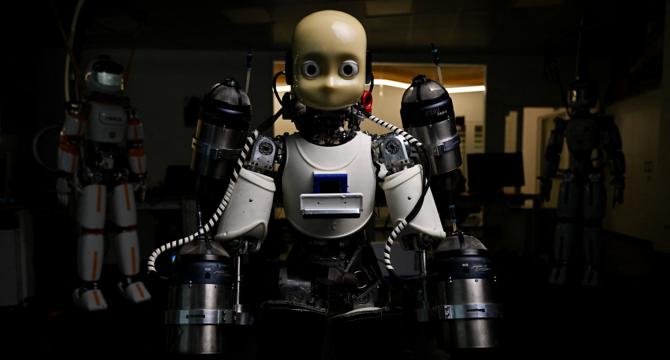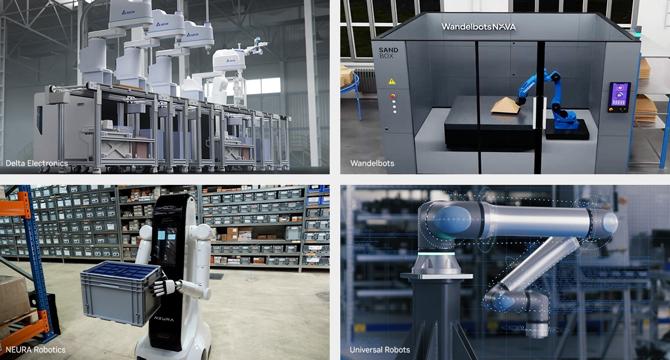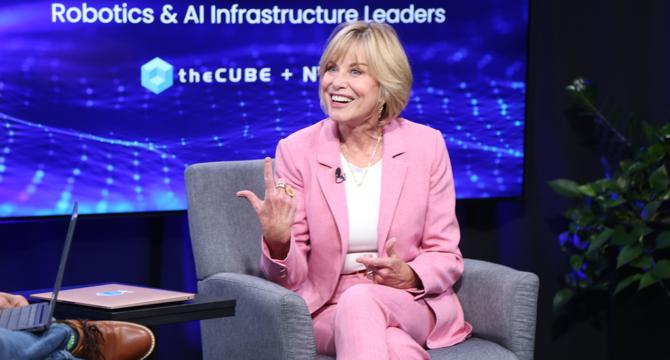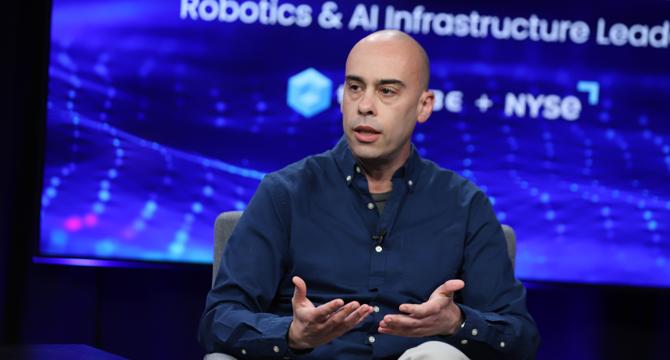Robotics News
The Robot Report
226

NAU researchers release open-source exoskeleton framework
- Researchers at Northern Arizona University released an open-source robotic exoskeleton to help people with disabilities walk on their own with the help of robotic legs.
- The open-source system, called OpenExo, provides instructions for building single- or multi-joint exoskeletons, including design files, code, and step-by-step guides, to lower barriers to entry for potential exoskeleton developers and researchers.
- The development of exoskeletons is complex, time-consuming, and expensive, but the OpenExo framework aims to address these challenges by allowing new developers to build upon previous work.
- The research at NAU has already helped children with cerebral palsy and patients with gait disorders optimize their rehabilitation, with further potential for positive impact on individuals' lives through advancements in exoskeleton technology.
Read Full Article
13 Likes
The Robot Report
74

A beginner’s guide to safe human-robot collaboration
- Standards ensure safe human-robot collaboration in factories, homes, and hospitals.
- Robot safety standards reduce collision risks and define safe operation requirements.
- Global standards bodies develop guidelines for human-robot safety across various regions.
- Businesses enforce compliance with safety standards even where not legally mandated.
- Robust testing ensures robot products meet safety requirements for effective human-robot coexistence.
Read Full Article
4 Likes
Eu-Startups
52

Unchained Robotics secures €8.5 million to help clients find the right automation technology
- Unchained Robotics secures €8.5 million in Series A extended funding to address automation challenges.
- Funding round backed by Direttissima Growth Partners, Navivo Capital, Future Industry Ventures, vent.io, and D11Z.
- Unchained Robotics aims to simplify automation for SMEs, offering affordable solutions without special expertise.
- Founded in 2019 by Kevin Freise and Mladen Milicevic, the company provides an independent automation platform.
- The company offers configurable solutions and turnkey systems with its LUNA OS software.
- LUNA OS is a standardised control system that simplifies integrating robots into production lines.
- Over 300 European companies, including Vorwerk, are already using Unchained Robotics' solutions.
- Expansion into the U.S. is underway, with a partnership with Albéa Group for automation initiatives.
- Unchained Robotics focuses on standardisation and scalability in robotic automation.
- The company emphasizes the importance of automation in staying competitive, especially in manual tasks.
- Future plans involve enhancing adaptability and learning in robotic systems through AI technology.
- The funding aims to accelerate Unchained Robotics' growth and innovation in the automation sector.
- Christopher Hoffmann of Direttissima Growth Partners highlights the company's role in standardizing automation.
- Automation is seen as key to addressing workforce shortages in manual tasks by 2030.
- Unchained Robotics envisions AI-powered robotic systems that are adaptable and intelligent.
- The company's focus is on bridging intelligent software with physical automation systems.
- The article is eligible for web story generation.
Read Full Article
3 Likes
The Robot Report
104

NBC’s AGT pushes Spot to perform under pressure
- Boston Dynamics showcased five Spot robots performing a synchronized dance routine on NBC's America's Got Talent (AGT) to Queen's 'Don't Stop Me Now.'
- All four AGT judges voted 'yes' for Spot, seeing it as a unique and mind-blowing performance.
- The live performance on AGT served as a technical stress test for Spot and Boston Dynamics' robotics engineers.
- The choreography involved autonomous and teleoperated components, pushing Spot's limits with aggressive movements.
- Recent advances in reinforcement learning and behavior modeling enhanced Spot's capabilities for such performances.
- One Spot robot experienced a rare hardware fault mid-routine, turning it into a moment of authenticity and resilience.
- The performance aimed to reshape public perception of robotics and inspire the next generation of engineers.
- Boston Dynamics sees these performances as a way to emphasize the helpful nature of robots and spark interest in robotics.
- The team's motto 'build it, break it, fix it' was exemplified during the live performance on AGT.
- Boston Dynamics is waiting to hear if Spot will advance to the next round of AGT and plans for more sophisticated routines.
Read Full Article
6 Likes
Discover more
The Robot Report
428

Apptronik launches Elevate Robotics to commercialize non-humanoid robots
- Apptronik, a Texas-based developer, has launched Elevate Robotics to focus on automating industrial tasks beyond humanoid robots.
- Elevate will concentrate on heavy-duty, industrial-scale work by commercializing non-humanoid robots.
- Apptronik will continue its focus on the Apollo humanoid while Elevate works on multipurpose automation solutions.
- Elevate Robotics will be led by CEO Paul Hvass, a co-founder at Plus One Robotics.
- Apptronik raised $403 million in Series A funding to support Apollo production.
- They are targeting industries like automotive, electronics manufacturing, logistics, bottling, and consumer goods.
- Apptronik has agreements with Mercedes-Benz, GXO Logistics, and Google DeepMind for real-world testing.
- The humanoid robot market has seen slow commercial deployments despite high investments.
- Agility Robotics deployed a small fleet of Digit humanoids at a Spanx facility in 2024.
- Figure AI and Hyundai Motor Group are also making moves in the robotics market.
- Elevate Robotics intends to expand the possibilities of industrial-scale work with its robotics innovations.
- Elevate will apply novel technology to tackle heavy-duty tasks in various sectors.
- Apptronik has developed groundbreaking robotics technology for humanoid robots and beyond.
- The company has built over 15 robotics systems and made significant technological advancements.
- Elevate's robots use patented gravity compensation technology to lift more than they weigh.
- The post was originally seen on The Robot Report.
Read Full Article
25 Likes
The Robot Report
401

The road ahead for robotics: Insights from Motional’s Major and Foundation’s Pathak
- Episode 201 of The Robot Report Podcast features interviews with Laura Major, CEO of Motional, and Sankaet Pathek, CEO of Foundation.
- Motional focuses on AI and machine learning in autonomous vehicles, emphasizing real-world testing and safety.
- Foundation is working on humanoid robots with practical applications, emphasizing team building and innovation.
- European automotive robot sales remain strong, with 23,000 new installations in 2024, surpassing North America.
- SoftBank plans a $1 trillion industrial complex in Arizona for robot and AI development.
- Laura Major appointed as president and CEO of Motional as they prepare for a driverless commercial service launch in 2026.
Read Full Article
24 Likes
The Robot Report
222

ForSight Robotics raises $125M for cataract surgery tech
- ForSight Robotics completed a $125 million Series B funding round to support its ophthalmic robotic surgery tech.
- Eclipse led the financing, with an undisclosed strategic investor and Fred Moll, the father of surgical robotics, participating.
- The funding brought ForSight Robotics' total funding to $195 million.
- The company plans to use the funds to accelerate the growth phase for its Oryom platform, the world's first robotic surgery platform for cataracts and eye diseases.
- Oryom uses AI-based algorithms, advanced computer vision, and miniaturized mechanics for precise ophthalmic procedures.
- It offers improved ergonomic experience, dexterity, and maneuverability for surgeons.
- The platform allows access to anterior and posterior segments for glaucoma and retinal surgery treatments.
- ForSight Robotics aims to launch first-in-human clinical trials this year.
- The company sees ophthalmology as the next frontier in the robotics revolution and aims to bring transformative impact to eye surgery.
- The NHS of England plans to support half a million robotic operations annually by 2035, up from 70,000 in 2023 and 2024.
- Millions of patients are expected to benefit from robotic surgery efforts to reduce waiting times.
- The article was republished from sister website MassDevice.
- ForSight Robotics is focused on advancing robotic surgery technology for eye procedures.
- The company aims to address the precision and complexity unique to eye surgeries.
- The Oryom platform enables surgeons to navigate complex angles within the human eye.
- AI, computer vision, and miniaturized mechanics are utilized to perform eye surgeries.
- The funding round will facilitate the development and launch of innovative robotic solutions for ophthalmology.
Read Full Article
13 Likes
The Robot Report
201

ABB Robotics launches large industrial robots, heavy duty AMR at Automatica
- ABB Robotics introduced high-performance robots, including the IRB 670S, expanding its large robot portfolio.
- The new robots support the vision that 'versatility' will be key for robotics in 2025, offering flexibility and sustainability benefits.
- The new IRB 6730S and IRB 6750S shelf-mounted robots aim to increase robot density in production lines, capable of handling payloads up to 350 kg.
- IRB 6760 press-tending robot is designed for mid-sized press lines, boosting production output with carbon-fiber tooling boom.
- All three new robots are powered by OmniCore controllers, delivering energy consumption reduction and high performance.
- ABB also launched the Flexley Mover P603 platform, an AMR for heavy payloads, with AI-driven navigation and safety features.
- The P603 AMR offers positioning accuracy, speed, and does not require reflectors or infrastructure changes.
- The compact design of the P603 makes it suitable for various applications in intralogistics.
- The AMR works with AMR Studio software for setup and customization, reducing commissioning time, and integrates with Fleet Manager for real-time coordination of multiple robots.
- ABB envisions an era of 'autonomous versatile robotics' with core capabilities including human-robot interaction, sensing, and perception, autonomous reasoning, and motion control.
Read Full Article
12 Likes
TechCrunch
267

Image Credit: TechCrunch
Google rolls out new Gemini model that can run on robots locally
- Google DeepMind released a new language model called Gemini Robotics On-Device that can run tasks locally on robots without an internet connection.
- Gemini Robotics On-Device can control a robot's movements and be fine-tuned using natural language prompts.
- The model performs well in benchmarks compared to cloud-based models and outperforms other on-device models.
- Google demoed the model with robots performing tasks like unzipping bags and folding clothes.
- Gemini Robotics On-Device was trained on ALOHA robots and later adapted for use on other robots like the bi-arm Franka FR3 and Apollo humanoid robots.
- The bi-arm Franka FR3 robot successfully handled new scenarios and tasks it hadn't encountered before.
- Google is also releasing a Gemini Robotics SDK for developers to train robots on new tasks using the MuJoCo physics simulator.
- Nvidia, Hugging Face, and Mirae Asset-backed Korean startup RLWRLD are also working on AI models and platforms for robotics.
- Nvidia is building a platform for humanoids, Hugging Face is developing open models for robotics and working on robots, and RLWRLD is creating foundational models for robots.
Read Full Article
16 Likes
Livescience
371

Image Credit: Livescience
Intrepid baby-faced robot dons a jetpack for its next adventure — becoming the first humanoid robot to fly
- iRonCub MK3, a humanoid robot, achieves successful vertical liftoff using four thrusters.
- The robot, based on iCub, stands 3 feet tall, weighs 49 pounds, and has a "baby face" head.
- Designed by the RobotCub Consortium, iCub is a testbed for AI research since 2009.
- The iRonCub is the first jet-powered humanoid robot capable of vertical takeoff.
- Adding aerial mobility to robots like iRonCub can aid in search and rescue missions and repairs in hazardous environments.
- The robot is controlled through a VR helmet with load-bearing brackets for the jetpack and heat-resistant panels.
- The engineering team used MPC for flight control and performed FEM analysis to ensure the chassis can handle flight stress.
- Real-world tests followed computer simulations, focusing on enhancing the flight controller for external disturbances.
- Plans for the future iterations include adding back the forearms to the iRonCub robot.
- The iRonCub project showcases the potential of flying humanoid robots for various applications.
Read Full Article
22 Likes
Nvidia
436

Image Credit: Nvidia
NVIDIA and Partners Highlight Next-Generation Robotics, Automation and AI Technologies at Automatica
- Europe is adopting industrial AI and advanced robotics to address labor shortages and boost productivity.
- NVIDIA and partners are showcasing next-generation robotics and AI technologies at Automatica in Munich.
- Europe's first industrial AI cloud with NVIDIA GPUs supports manufacturing applications.
- NVIDIA introduces humanoid robot reasoning model Isaac GR00T N1.5 for material handling and manufacturing tasks.
- NVIDIA releases Isaac GR00T-Dreams blueprint for robot training and adaptation to new environments.
- NEURA Robotics unveils humanoid robot 4NE1 trained in Isaac Sim before real-world deployment.
- Delta Electronics debuts collaborative robots D-Bot Mar and D-Bot 2 in 1 trained using Omniverse and Isaac Sim.
- Wandelbots partners with SoftServe to scale automation using NVIDIA Isaac Sim.
- Companies like Cyngyn, Doosan Robotics, Hexagon, Intrinsic, SCHUNK, and Universal Robots showcase AI robotic solutions at Automatica.
- Vention launches Machine Motion AI powered by Jetson AGX Orin and expands robotic offerings with Franka Robotics' FR3.
Read Full Article
26 Likes
The Robot Report
284

Inbolt to bring its real-time robot guidance systems to the U.S., Japan
- Inbolt, a developer of real-time robot guidance systems, is expanding to the U.S. and Japan, aiming to replicate its success in the European market.
- The company's GuideNOW system includes a 3D camera, real-time workpiece localization AI, and GuideNOW Studio.
- Inbolt's technology enables industrial robots to adapt to dynamic environments, offering precise part localization and trajectory adjustments.
- The AI, trained on CAD models in under 5 minutes, integrates with systems from FANUC, ABB, KUKA, and Universal Robots.
- Inbolt has powered over 20 million robot cycles in the first half of 2025, leading to returns on automation for customers.
- The startup is responding to the growing demand for automation, with automation being a top priority for many manufacturers globally.
- Inbolt, with funding from a Series A round, plans to establish local teams in the U.S. and Japan and hire robotics application engineers.
- The company envisions a future of fully autonomous factory floors with machines that can see, think, and respond in real time.
- Inbolt sets up base in Detroit and Tokyo, leveraging America's commitment to reshoring and Japan's strong R&D market for expansion.
- The company's GuideNow system won a 2023 RBR50 innovation award for its 3D vision servoing and real-time guidance technology.
Read Full Article
17 Likes
Siliconangle
26

Image Credit: Siliconangle
Why private cloud is AI’s next battleground, and Broadcom’s big advantage
- Private cloud is becoming increasingly important, with companies like Broadcom at the forefront of the AI battleground.
- Diane Bryant, a board member at Broadcom, discusses the complexity of AI and the advantage it provides to big companies like Google and Amazon.
- The AI hardware market is projected to reach between 300 to 500 billion in 2030, accommodating various players like Nvidia and AMD.
- Bryant highlights the history and evolution of AI, from its conceptual beginnings in the '50s to its recent breakthroughs.
- Broadcom's acquisition of VMware positions it well in the cloud and AI space, offering solutions like VMware Cloud Foundation for AI workloads.
- Bryant's involvement with companies like mmTron and Celestial AI shows her continued interest in innovative technologies such as photonics.
- Celestial AI's Photonic Fabric aims to enhance data transmission using optics, providing integration with accelerator chips for improved efficiency.
- SiliconANGLE Media, co-founded by John Furrier and Dave Vellante, focuses on digital media innovation and technology industry insights.
Read Full Article
1 Like
The Robot Report
302

VC reflects on robotics trade show season
- May and June were significant months for robotics in the U.S. with trade shows in Boston, Detroit, Houston, and Atlanta showcasing new technologies.
- Automate, organized by A3, highlighted the positive impact of robots on job creation and productivity.
- Interest in Cambrian Robotics surged with demonstrations of advanced AI-infused technologies at trade shows.
- Startups like Kinisi and Nexus Intelligence showcased innovative AI-driven robotics solutions at Automate.
- Xponential in Houston revealed advancements in defense technology with a focus on autonomous systems and drones.
- The relation between startups and the military has transformed, with significant investment in defense tech companies like Anduril.
- Anduril's success in securing a substantial funding round reflects the potential growth in the defense tech market.
- Palmer Luckey discussed Anduril's development of autonomous fighter jets for the U.S. Air Force.
- The robotics trade show season concluded in Boston with Robotics Tech Week, featuring discussions on industry growth and technological advancements.
- Oliver Mitchell's book launch at MassRobotics signified a reflection on the industry's progress and future prospects.
Read Full Article
18 Likes
Siliconangle
183

Image Credit: Siliconangle
Rise of the AI developer: How coding agents are redefining software engineering
- Augment Code believes that coding agents reduce time-to-code from days to hours, allowing engineers to focus on higher-level decisions.
- Coding agents place humans in managerial roles to curate output and guide development rather than replacing them.
- AI agents are transforming software development, maintenance, and scalability, discussed at theCUBE event.
- Coding agents aim to augment developers' productivity by speeding up tasks previously taking hours, days, or weeks.
- Supervision is crucial for coding agents to prevent technical debt accumulation and ensure high-quality, scalable code.
- Multi-agent collaboration is emerging, allowing engineers to orchestrate agents to work on different parts of a system simultaneously.
Read Full Article
9 Likes
For uninterrupted reading, download the app